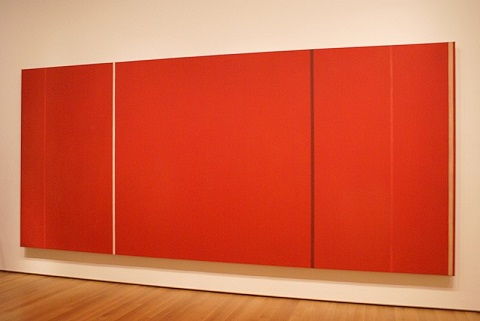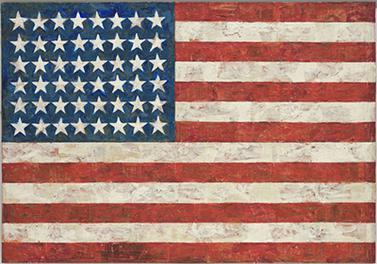Summary of Frank Stella
In 1959, Frank Stella gained early, immediate recognition with his series of coolly impersonal black striped paintings that turned the gestural brushwork and existential angst of Abstract Expressionism on its head. Focusing on the formal elements of art-making, Stella went on to create increasingly complicated work that seemed to follow a natural progression of dynamism, tactility, and scale: first, by expanding his initial monochrome palette to bright colors, and, later, moving painting into the third dimension through the incorporation of other, non-painterly elements onto the canvas. He ultimately went on to create large-scale freestanding sculptures, architectural structures, and one of the most complex works ever realized in the medium of printmaking. Stella's virtually relentless experimentation made him a key figure in American modernism, helping give rise to such developments as Minimalism, Post-Painterly Abstraction, and Color Field Painting.
Accomplishments
- A decisive departure from Abstract Expressionism, Stella's Black Paintings series consists of precisely delineated parallel black stripes produced by smoothly applied house paint. The striped pattern serves as a regulating system that, in Stella's words, forced "illusionistic space out of the painting at a constant rate." This device was intended to emphasize the flatness of the canvas and prompt the viewer's awareness of painting as a two-dimensional surface covered with paint - thereby overturning the notion of painting as window onto three-dimensional space that emerged in the Renaissance and dominated the medium for many centuries thereafter.
- Created according to a predetermined, circumscribed system imposed by the artist, the Black Paintings served as an important catalyst for Minimalist art of the 1960s. Similar to Stella's parallel stripes and smooth handling of paint, Minimalist artists created abstract works characterized by the use of repeated geometric, industrial-appearing shapes stripped of all thematic or emotional content.
- Stella was an early practitioner of nonrepresentational painting, rather than artwork alluding to underlying meanings, emotions, or narratives, and has remained one to this day. Working according to the principle of "line, plane, volume, and point, within space," Stella focused on the basic elements of an artwork - color, shape, and composition. Over time, Stella succeeded in dismantling the devices of three-dimensional illusionism; his shaped canvases underscored the "object-like" nature of a painting, while his asymmetrical Irregular Polygons explored the tension between the arrangement of colors on the flat surface of the canvas as well as the optical effect of the advancing and receding forms.
- Baroque artists such as the early-17th-century Italian painter Caravaggio developed illusionistic "tricks" that convincingly suggested that their subjects emerged out of the canvas and into the space of the viewer. Several centuries later, Stella took such innovations one step further by literally extending painting into the third dimension in his painterly reliefs, which entered the viewer's space with their incorporation of protruding materials.
Important Art by Frank Stella
The Marriage of Reason and Squalor, II
Belonging to the artist's groundbreaking series Black Paintings, The Marriage of Reason and Squalor is composed of black inverted parallel U-shapes containing stripes separated by thin lines of unpainted canvas. The repeated geometric pattern, in combination with the work's lack of figuration or expressive brushwork, prompts the viewer's recognition of it as a flat surface covered with paint, rather than a depiction of something else, upending the centuries-long concept of painting as window onto illusionistic three-dimensional space. The Black Paintings' stark simplicity, impersonal handling of the medium, and use of repeated geometric forms made them enormously influential on the emergence of Minimalism, whose practitioners likewise pursued the viewer's pure interaction with the art object. Along with three other of the Black Paintings, this work was included in the seminal MoMA exhibition Sixteen Americans. As if denying the painting's evocative title, Stella issued his famous maxim "What you see is what you see," in relation to this painting.
Enamel on canvas - The Museum of Modern Art, New York
Harran II
In his exploration of formal issues, Stella habitually worked in series, developing increasingly complicated variations on selected themes. In contrast to the monochrome Black Paintings, the Protractor series, to which Harran II belongs, deploys a vivid palette and composition consisting of rectangular shapes superimposed on curving and circular forms. As in The Marriage of Reason and Squalor, Harran II's stripes emphasize the flatness of the composition, reminding the viewer that a painting is merely canvas covered with paint. This concept is reinforced by the use of the shaped canvas, which, challenging the conventional rectangular format, further denies the painting's status as illusionistic window and enhances its "object-like" quality. Harran II - whose title comes from the name of an ancient city in Asia Minor - invites parallels with sculpture as well as architecture. Measuring a massive 10 x 20 feet, the work is architectural in scale, while its composition was based on the semicircular drafting tool for measuring and constructing angles.
Polymer and fluorescent polymer paint on canvas - The Solomon R. Guggenheim Museum, New York, New York
Michapol I
The shaped canvas recurs in the works of Stella's Polish Village series, to which Michapol I belongs. Each composition is developed from color variations and interlocking geometric forms influenced in part by Russian Constructivism. Also inspired by Polish synagogues of the 17th through the 19th centuries, the works of the Polish Village series are large-scale collages, in which the artist pasted felt, paper, and wood onto the stretched canvas. Despite their sculptural qualities, Stella described the impulse behind Michapol I and the other works of the series as "pictorial."
Mixed media on canvas - The Museum of Contemporary Art, Los Angeles
Shoubeegi
The present piece is part of Stella's Indian Bird series, in which the artist further expanded the category of "painting." Stella deployed painted curlicue aluminum forms that jut out into the viewer's space - increasing the works' object-like nature and diminishing their appearance as paintings hanging on a wall. Stella's use of assembled parts and three-dimensional elements notwithstanding, he still regarded the Indian Bird series - at the time his most sculptural work - as consisting of paintings or painted reliefs. Seen by some at the time as "disco-like," the series' garishly colorful palette - produced by adhering particles of metal shaving or ground glass to a first layer of color, which were then painted or stained over - was also new to his oeuvre. Stella began the series during his 1977 stay in Ahmedabad, naming the individual works after birds found on the Indian subcontinent.
Enamel and glitter on metal - San Francisco Museum of Modern Art, San Francisco
The Fountain
In the Fountain, Stella further explored the boundaries between artistic media. Although mural-sized, the piece - measuring 7 x 23 feet - is not a painting, but a print. The Fountain was Stella's most extensive work on paper and his culminating achievement in the medium of printmaking - a vital aspect of Stella's work since the 1960 - utilizing seven processes and sixty-one different colors. The piece belongs to a large, diverse series Stella created between 1985 and 1997 based on Herman Melville's Moby Dick. As such, for Stella it constituted an homage of sorts to Abstract Expressionism, a number of whose artists also created works inspired by Ahab's epic struggle with the whale. Fittingly, and in keeping with the nonrepresentational nature of Stella's work, The Fountain is abstract, reflecting Stella's goal of conveying both a sense of motion and the power of the story, rather than the specific narrative.
Print, relief, intaglio, stencil, collage and hand-coloring - National Gallery of Australia, Canberra
Prinz Friedrich von Homburg, Ein Schauspiel, 3X
Given Stella's creation of numerous, at times large-scale, paintings with protruding three-dimensional elements, the production of freestanding sculptures or architectural structures might have seemed the next logical step for the artist. Prinz Friedrich von Homburg, Ein Schauspiel, 3X is just that - a massive composition whose spiraling forms and clusters continues the visual lexicon of the artist's painterly reliefs. Sitting outside the National Gallery of Art, it is one of Stella's first monumental works - weighing in just under ten tons and measuring an enormous 31 x 39 x 34 feet. The title comes from the name of a play by the 18th-century German playwright Heinrich von Kleist about love and war.
Stainless steel, aluminum, painted fiberglass and carbon fiber - The National Gallery of Art, Washington DC
Biography of Frank Stella
Childhood
Frank Stella was born the oldest of three children to first-generation Italian-American parents Frank and Constance (née Santonelli) Stella. Both his parents were art lovers, and his mother had attended art school and enjoyed painting landscapes. His father was a gynecologist. As a child, Stella suffered an accident that left him with missing joints in the fingers on his left hand, which later (around 1958) caused him to fail the Army physical and to be exempted from service during the Vietnam war.
In Stella’s sophomore year of high school at Phillips Academy in Andover, Massachusetts, he began learning to paint from the abstractionist Patrick Morgan. Another one of his high school teachers was the painter Bartlett H. Hayes Jr., who introduced him to the work of Hans Hofmann and Josef Albers.
Early Training
Stella continued taking art courses at Princeton University, while earning a degree in history. His Princeton professors, painter Stephen Greene and art historian William Seitz, introduced Stella to the New York art world by bringing him to exhibitions in the city, thereby shaping his earliest artistic aesthetic. These trips to New York galleries exposed Stella to artists such as Jackson Pollock, Franz Kline, and, most critical for Stella's subsequent development, Jasper Johns, whose geometric paintings of flags and targets inspired Stella's work during his Princeton years. It was also there that he befriended future critic Michael Fried and future Color Field painter Walter Darby Bannard.
After graduating in 1958, Stella moved to the Lower East Side of New York, where he set up a studio in a former jewelry store, and also made some money painting houses. In 1961, he married a woman named Barbara Rose, who at the time was studying art history, and was soon to make a name for herself as a critic. Together they had two children, Rachel and Michael.
It wasn’t long before Stella himself attracted significant amounts of attention from the art world. Deploying a monochromatic palette and flat application of paint, his early work signaled a break from the thick, gestural brushstrokes of the Abstract Expressionists. Stella famously called a painting "a flat surface with paint on it - nothing more," reflecting his view of art as an end in itself rather than a representation of emotional, intellectual, or physical states. With emphasis on form rather than content, his early paintings are often credited with launching Minimalism.
For his first major series, the stark Black Paintings (1958-60), Stella covered canvases with black house paint, leaving unpainted pinstripes in repetitive, parallel patterns. At only twenty-three years old, he gained instant recognition for these groundbreaking works. The Museum of Modern Art included four in its 1959-60 exhibition Sixteen Americans, and purchased one for its permanent collection. That same year, famed gallery owner Leo Castelli began representing Stella.
Mature Period
From his Black Paintings, Stella moved onto the Aluminum Paintings (1960) and the Copper Paintings (1960-61), for which he created his own geometrically shaped canvases, challenging the traditional rectangular format. Much of his work at this time drew on the stripe motif first deployed in the Black Paintings, but he soon began to embrace complex circular motifs as well as a brighter palette, especially in the Irregular Polygon (1965-67) and Protractor (1967-71) series. Critic Peter Schjeldahl has noted that Stella was “a god of the sixties art world, exalting tastes for reductive form, daunting scale, and florid artificial color.” During this period, Stella also began delving into printmaking, an aspect of his work he passionately pursued throughout the remainder of his career.
In 1970, one year after divorcing Rose, Stella was the youngest artist to have a retrospective at New York's Museum of Modern Art, and then, receiving a second retrospective seventeen years after - the first living artist to earn the latter distinction. Following this exhibition, Stella again explored new artistic avenues, this time incorporating collage and relief into his paintings - an extension of the layered bands of color in his previous works. For the Polish Village series (1970-73), he attached paper, felt, and wood to the canvas. And building on this trajectory, the later Indian Bird series (1977-79) featured an assemblage of painted aluminum forms protruding from the wall, reflecting his growing interest in three-dimensionality and dynamic textures. He continued pushing the idea, creating sculptural works marked by elaborate tangles of curves, spirals, and loops - pieces whose exuberance present a stunning contrast to the more somber Black Paintings that had first brought him into the public eye. Yet for Stella, even these highly sculptural works were still paintings; he asserted, "A sculpture is just a painting cut out and stood up somewhere.”
For a time in the 1970s, Stella carried on a romantic relationship with Shirley De Lemos Wyse, with whom he had one daughter, Laura. Then, in 1978, he married a second time, to Dr. Harriet E. McGurk, a pediatrician, with whom he had two more sons, Patrick and Peter.
In the early 1980s he travelled to Rome where he studied the works of Caravaggio. Stella later remarked “The space that Caravaggio created is something that 20th-century painting could use: an alternative both to the space of conventional realism and to the space of what has come to be conventional painterliness.” Back in the United States, he lectured at Harvard University from 1983-84.
Late Period and Death
In the 1980s and 1990s, Stella expanded his three-dimensional paintings into increasingly explosive, vividly colored, and multifaceted pieces, while continuing his work in printmaking. His series based on Herman Melville's Moby Dick included works of many techniques, from metal reliefs to giant sculptures to mixed-media prints combining diverse processes such as woodblock printing, etching, and hand-coloring. After moving in the direction of freestanding bronze and steel sculptures, Stella's work then expanded to encompass architectural structures, illustrating his statement, "It's hard not to think about architecture when you've gone from painting to relief to sculpture." These works include an aluminum band shell in Miami (1999) and a monumental sculpture, Prinz Friedrich von Homburg, Ein Schauspiel, 3X (1998-2001), situated on the lawn of the National Gallery of Art in Washington, D.C.
Stella spent his final years living and working in New York, continuing to create large-scale sculptures, as well as designs for potential architectural projects. He passed away from lymphoma in 2024. In addition to his wife and five children, he is survived by five grandchildren. In his New York Times obituary for Stella, culture reporter William Grimes lauded the artist as “a restless, relentless innovator whose explorations of color and form made him an outsize presence.”
The Legacy of Frank Stella
Stella was one of the greatest postwar artists whose impact continues to be felt in the work of many contemporary American artists and styles. Although he never regarded himself as a Minimalist, Stella's Black Paintings secured their creator's place in art history by inspiring such artists as Carl Andre to create sculptural objects stripped of expressive content and marked by their industrial appearance and seemingly anonymous handling of repeated geometric forms. Stella's color variations, exploration of circular motifs, and shaped canvases influenced artists like Kenneth Noland and served as a catalyst for such developments as Color Field Painting and Post-Painterly Abstraction.
Art critics and theorists took much from Stella's work as well. Clement Greenberg famously said, "Where the Old Masters created an illusion of space into which one could imagine walking, the illusion created by a Modernist is one into which one can look, can travel through, only with the eye." Greenberg derived his concepts of flatness, the integrity of the picture plane, and optical integrity from the work of Stella and other modernists of the time. Stella's ideas also inspired other major theorists of the period such as Carl Andre, Donald Judd, and Michael Fried.
Influences and Connections

-
![Clement Greenberg]() Clement Greenberg
Clement Greenberg -
![Philip Johnson]() Philip Johnson
Philip Johnson ![Richard Meier]() Richard Meier
Richard Meier
-
![Frank Gehry]() Frank Gehry
Frank Gehry -
![Sol LeWitt]() Sol LeWitt
Sol LeWitt -
![Dan Flavin]() Dan Flavin
Dan Flavin ![Daniel Libeskind]() Daniel Libeskind
Daniel Libeskind
Useful Resources on Frank Stella
- Frank Stella: American Abstract ArtistBy James Pearson
- Frank Stella: The Museum of Modern ArtOur PickBy William S. Rubin
- Three American Painters: Kenneth Noland, Jules Olitski, Frank StellaOur PickBy Michael Fried
- Frank Stella: An Illustrated BiographyBy Sidney Guberman
- Frank Stella: Irregular PolygonsOur PickBy Brian P. Kennedy
- Frank Stella: 1970-1987By William Rubin, Frank Stella
- Frank Stella 1958By Harry Cooper, Megan R. Luke
- The Prints of Frank Stella: A Catalogue RaisonneBy Frank Stella, Richard H. Axsom
- Frank Stella (Phaidon Contemporary Artists Series)By Andrianna Campbell, Kate Nesin, and Lucas Blalock
- Frank Stella: Prints: A Catalogue RaisonnéBy Richard Axsom, Carolyn Vaughn, Sigrid Asmus, and Laura Morris
- Frank StellaOur PickBy Jörg Daur
- Frank Stella: A RetrospectiveBy Michael Auping
- Frank Stella's Moby-Dick: Words and ShapesOur PickBy Robert K. Wallace
- Frank Stella Unbound: Literature and PrintmakingBy Mitra Abbaspour, Calvin Brown, and Erica Cooke































